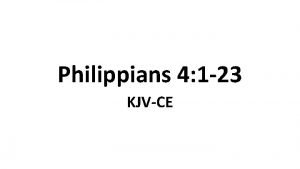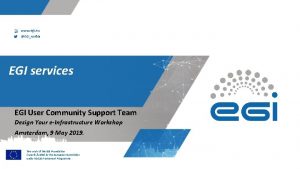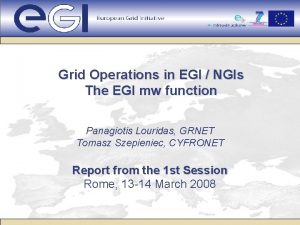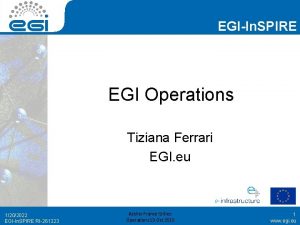EGI Operations Vision Notwithstanding the different and evolving





- Slides: 5

EGI Operations Vision • Notwithstanding the different and evolving needs of application communities and NGIs, a key component of the EGI vision is the provision of a large-scale, production Grid infrastructure – built on National Grids that interoperate seamlessly at many levels, offering reliable and predictable services to a wide range of applications, ranging from “mission critical” to prototyping and research. • It is understood that it will be a long and continuous process to reach this possibly utopian goal, with additional NGIs and/or application communities joining at different times, with varying needs and different levels of “maturity” • In addition, sites of widely varying size, complexity and stage of maturity must clearly be taken into account • However, it is felt important to emphasize this “vision” as a key component of the proposed EGI / NGI strategy • The EGI must also have a role in the appropriate policies, such as “standards” closely related to operational aspects and security • Including Low Cost of Entry & Low Cost of Ownership 1

EGI Operations Implementation • By definition, Grids federate different management domains • To deliver on the vision above, EGI must federate a variety of operational aspects – some of which are implemented by NGIs and / or component sites – but make available key data (monitoring, accounting, …) in a consistent and eventually aggregated manner • In particularly, highly centralized models – e. g. for monitoring – have been shown to be both intrusive and non-scalable multi-level hierarchical operations model • e. g. EGI / NGI / local-Grid / Site / … • Whilst building on the positive experience of today’s production grids, these concerns must nevertheless be taken into account as part of the EGI / NGI architecture • This includes designing and deploying for low-cost-of entry & ownership, whilst maintaining sufficient flexibility to meet the requirements of the Application clusters 2

EGI Operations Cost Models • If the above represents sufficient consensus to allow us to move ahead – whilst not being cast in concrete – we should assemble a small group of operations experts to build a concrete functional and cost model for discussion well prior to the March 2008 Rome workshop MThe risk – if cannot come to an acceptable agreement ‘face-to-face’ is that we will fail to produce a realistic operations functional & cost model for Rome • As we expect – from the analysis done on Tuesday – OPS to be one of the more significant components of the overall cost of agreed EGI functions, this must be avoided! Ø A cost-benefit-analysis must be a key part of this work! 3

EGI OPS short-term WG • Possible composition: • Chair – ideally should be main author of document(s) and presentations for Rome • Secretary – to take notes from regular phone meetings • Expert representatives and key stake-holders • From a range of regions, e. g. large, medium, small, federated • The group must remain sufficiently small & focussed! • e. g. maximum 5(? ) people? Ø These people must be able to – and accept to – take on a non-negligible load and responsibility over the next 6 weeks! 4

“Volunteers” • • • Tiziana Per Rolf Fotis Jamie 5









